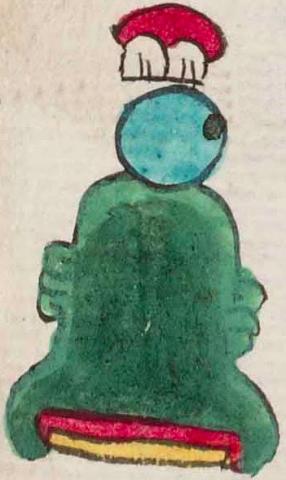Xoxouhtla (Mdz23r)
This compound glyph for the place name Xoxouhtla has three components, a hill or mountain (tepetl), silent here and perhaps a semantic complement that reinforces the locative], a circle with the color turquoise or blue-green (xoxouhqui), and teeth, which provide the phonetic locative -tlah, very close to the locative suffix -tlān, which is much more common. The teeth are the classic two, upper, front, white teeth with red gums, and as always, they re not meant to convey any meaning such as teeth, but rather place of abundance of something or simply place. The tepetl is the standard two-tone green bell shape with horizontal strips of red and yellow at the base. The color turquoise simply fills the circle in between the hill and the teeth.
Stephanie Wood
Because the final -n often drops off an intended -tlān in alphabetic writing, and because vowel length is rarely indicated in the colonial-era glosses, it is often impossible to know when -tla (or -tlah if we show the glottal stop) is actually meant in place of -tlān. [See Gordon Whittaker, Deciphering Aztec Hieroglyphs, 2021, 101.]
Stephanie Wood
xo xovtla puo
Xoxouhtla, pueblo
Stephanie Wood
c. 1541, or by 1553 at the latest
Stephanie Wood
greens, blues, mountains, nombres de lugares

xoxouh(qui), blue-green, https://nahuatl.wired-humanities.org/content/xoxouhqui
-tlah, where there is a lot of, https://nahuatl.wired-humanities.org/content/tla-1
"Where There's A Lot of Blue-Green" (Whittaker, 2021, 94)
(XO)XOUH-tla-MOUNTAIN
Codex Mendoza, folio 23 recto, https://digital.bodleian.ox.ac.uk/objects/2fea788e-2aa2-4f08-b6d9-648c00..., image 56 of 188.
The Bodleian Libraries, University of Oxford, hold the original manuscript, the MS. Arch. Selden. A. 1. This image is published here under the UK Creative Commons, “Attribution-NonCommercial-ShareAlike 3.0 License” (CC-BY-NC-SA 3.0).




